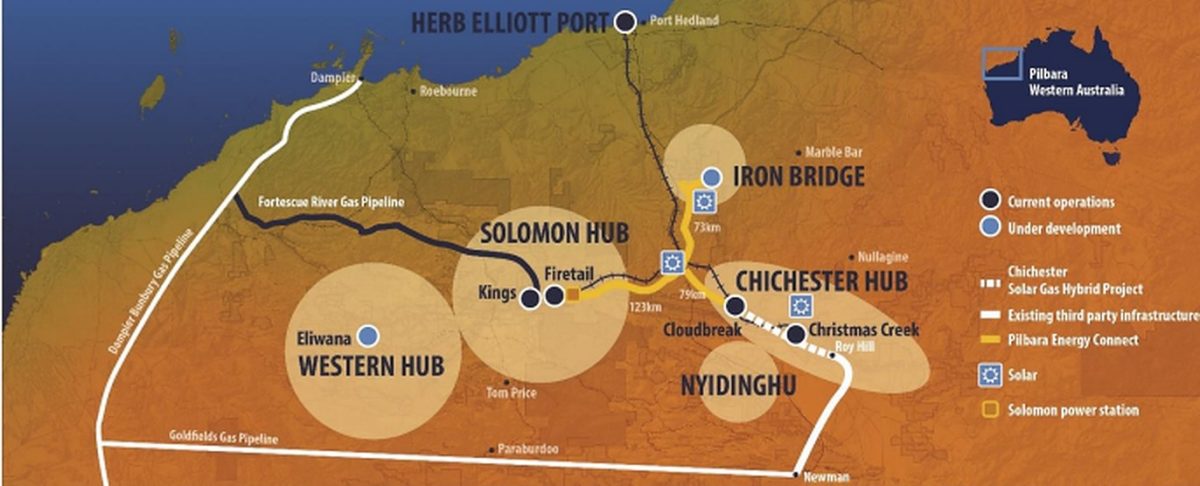Following a power transmission investment announced in October, Australian miner Fortescue Metals has unveiled plans for a new power generation project in the Pilbara. In a statement to the ASX on Thursday, the company announced it was set to invest $US450 million ($668 million) in the Pilbara Energy Generation project to enable low cost power to the Iron Bridge magnetite project.
The Pilbara Energy Generation project will include 150 MW of gas-fired generators coupled with 150 MW of solar PV and large-scale battery storage. The project complements the $US250 million investment in the Pilbara Transmission Project which will turn Fortescue’s Chichester Hub iron ore operations into a solar-powered hub.
The Chichester Solar Gas Hybrid project will be developed by power utility Alinta Energy. It will involve a 60 MW solar farm at the hub, 35 MW/11 MWh battery facility and the 60-kilometer transmission line linking Fortescue’s Cloudbreak and Christmas Creek mines with Alinta Energy’s 145 MW Newman gas-fired power station. The project is due for completion mid-2021.
To execute the project, Alinta Energy will receive $24.2 million in funding from the Australian Renewable Energy Agency (ARENA), and $90 million from the Northern Australia Infrastructure Facility (NAIF). The power utility has awarded contracts worth $165 million to Sydney-based Downer Group to build the 60 MW solar farm and supporting power infrastructure as part of the Chichester project.
As the offtaker of the project, Fortescue will be able to reduce the use of diesel by around 100 million liters annually, as the mines currently rely on diesel generators. This will allow up to 100% of daytime energy requirements for the Chichester operations to be powered by renewable energy, with the remaining power requirements to be balanced with gas generation.
Together, the transmission and generation projects, totaling US$700 million, form the Pilbara Energy Connect program, which will allow the miner to leverage its existing energy infrastructure including the Fortescue River Gas pipeline and generation capacity at the Solomon Power Station and support the incorporation of large-scale renewable energy.
“Pilbara Energy Connect allows for large scale renewable generation such as solar or wind to be connected at any point on the integrated network, positioning Fortescue to readily increase our use of renewable energy in the future,” Fortescue CEO Elizabeth Gaines said. “By installing 150 MW of solar PV as part of the Pilbara Generation Project, the modelling indicates we will avoid up to 285,000 tonnes of CO2e per year in emissions, as compared to generating electricity solely from gas.”
According to Gains, the lack of an integrated transmission network in the Pilbara has been a key barrier to entry for large-scale renewables but this will now be addressed by Fortescue’s investment. “Mining is a 24/7 operation and efficient, reliable, competitive energy generation remains an important consideration for the mining sector in Western Australia,” she said.
A growing number of Western Australian mines are already shifting to renewables, mirroring a growing trend in powering mining operations worldwide with wind or solar, or both. Last year, Agnew Gold Mining and GMA Garnet unveiled plans for major hybrid microgrid projects, featuring wind, solar, batteries, and gas at mines in remote locations at the fringe of Western Australia’s electricity grid, to mention a few.
Also on Thursday, Fortescue announced it had achieved a record shipment of iron ore in the December 2019 quarter with 46.4 million tonnes. The miner said the outbreak of coronavirus in China had not yet affected any of its iron ore shipments but that it was carefully monitoring the evolving situation.
This content is protected by copyright and may not be reused. If you want to cooperate with us and would like to reuse some of our content, please contact: editors@pv-magazine.com.









2 comments
By submitting this form you agree to pv magazine using your data for the purposes of publishing your comment.
Your personal data will only be disclosed or otherwise transmitted to third parties for the purposes of spam filtering or if this is necessary for technical maintenance of the website. Any other transfer to third parties will not take place unless this is justified on the basis of applicable data protection regulations or if pv magazine is legally obliged to do so.
You may revoke this consent at any time with effect for the future, in which case your personal data will be deleted immediately. Otherwise, your data will be deleted if pv magazine has processed your request or the purpose of data storage is fulfilled.
Further information on data privacy can be found in our Data Protection Policy.